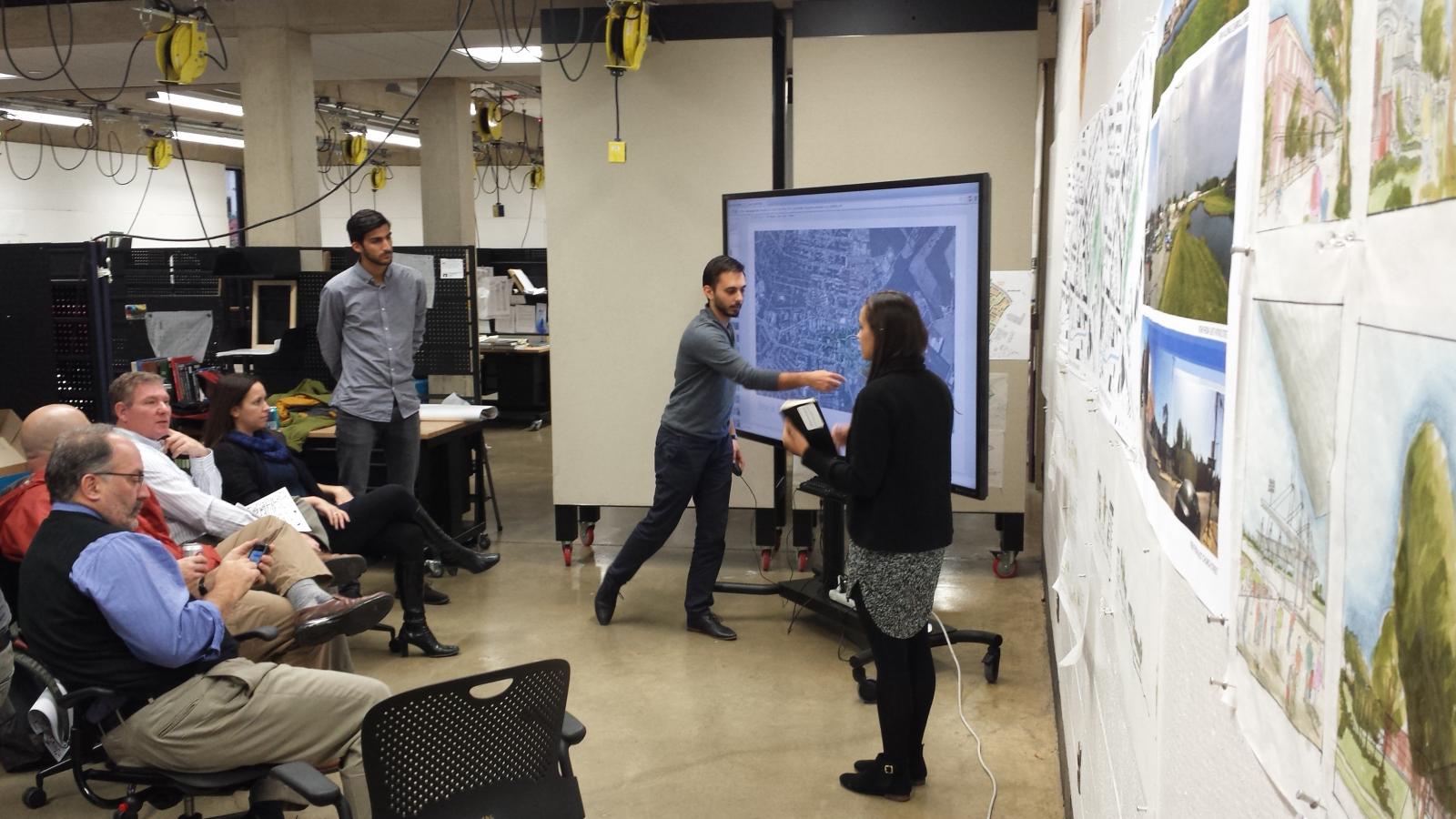Sixteen disciplines. Three hundred and fifty students. Nearly one million dollars in project value. This year, a new campus-wide program proved its strength in numbers, delivering sustainable solutions to environmental, social and economic challenges to two Maryland cities. Twenty-nine projects—which ranged from calculating greenhouse gas emissions to re-envisioning a downtown block—were the culmination of coursework from the inaugural year of the University of Maryland’s Partnership for Action Learning in Sustainability, or PALS.
Developed by the University’s National Center for Smart Growth, PALS pairs faculty expertise and student ingenuity with sustainability challenges facing Maryland communities. The PALS mission is to provide high quality, low-cost assistance to local governments while creating an active and valuable real-world learning experience for UMD students. PALS initiated its first partnership with The City of Frederick, Maryland in September of 2014, adding a second, smaller collaboration with College Park in January.
PALS students, faculty and administrators presented their second semester project findings to city officials, campus administrators and community stakeholders at public events in each city this past month. The year-end presentations offered both cities a snapshot of work and effort by the students, whose goal was to provide information and analysis that will help influence decision-making down the line, as well as offer recommendations for possible action.
The College Park presentation, which took place May 21, provided an overview of four projects addressing specific goals identified by the city: a calculation of College Park’s annual greenhouse gas emissions; designs for a new City Hall-University building; an examination of waste management practices; and how thought-provoking public art can bridge the town-gown relationship.
Students from Professor Robert Nelson’s Public Policy course, who addressed Green House Gas emissions with the assistance of Environmental Finance Center Program Manager Sean Williamson, proposed a new initiative, the Small Town Energy Program (STEP) as a way to continue the City’s trend of lowering its emissions. Modeled after successful programs in peer communities like University Park, the STEP Program would use a minimalist budget to provide residents audits and energy coaches, banking on the notion that most residents want to lower energy costs and shrink carbon footprints.
“I’m excited that we’re doing this and excited to see this presentation,” said College Park Councilman P.J. Brennan. “Reducing our greenhouse gas initiatives is a key goal for the City and this is an important step.”
“This partnership goes beyond our land grant mission as a university because the City of College Park is our home,” said Uri Avin, Director of the PALS Program. “Our students feel a duty and desire to make College Park a more vibrant, connected community. PALS is one way we can collaborate with the City to achieve that goal.”
Frederick’s event on May 25 highlighted seven of the nine spring projects developed by the Program, with several projects zeroing in on the more industrialized East Frederick area, exploring ways to connect the city, spur job growth and create a strong sense of place. A number of the teams consulted peer projects in developing their recommendations, a testament to the program’s interdisciplinary reach.
“What sets PALS courses apart from a typical learning experience is that we are working in tandem with all these other courses across campus,” explains Assistant Professor of Architecture Jana Vandergoot. “We’ve had so many great interactions between faculty and students from other programs. It’s been a bit of a game-changer for my students.”
“The exercises we completed in this class were unlike any I’ve ever experienced in or outside academic work,” explained UMD Sophomore Matthew Reilly, whose College Park Scholars course created a composting and organics recovery plan for Frederick restaurants. Reilly’s classmate, Austin Font, added “It taught me to consider and think in different ways and I find myself applying that thinking to situations everywhere now. It was a great opportunity.”
Frederick will benefit from one final course this summer, an urban planning studio taught by Professor Jim Cohen that will utilize the work conducted this past year to offer recommendations for enhancing Frederick’s existing sustainability plan. PALS commences a new partnership with Howard County this fall and plans to unveil coursework later this summer.
“PALS has been a great partnership and has provided invaluable information for our City; we’ll be able to use it for a long time coming,” said Frederick Mayor Randy McClement. “I think it shows what a true partnership in education can do.”
PALS Courses at a Glance, Spring 2015:
Frederick:
• Reimagining North East Street (Landscape Architecture)
• Composting and Organics Recovery at Downtown Frederick Restaurants
(College Park Scholars Program)
• Video Journalism’s ViewFinders: Frederick’s Eco Entrepreneurs (School of Journalism)
• East Frederick Industrial Redevelopment (Urban Planning Program)
• Development Potential of City’s Monocacy Blvd. Property (Architecture and Real Estate Development Programs)
• Golden Mile Minority Business Outreach (Urban Planning Program)
• Recreation and Stewardship in the Watershed (Landscape Architecture)
College Park:
• College Town: three architecture and urban design efforts, including a new College Park City hall/UMD office building (Architecture Program)
• Green House Gas Inventory in the public sector (School of Public Policy)
• “Making Place: Public Art and Design (Architecture and Urban Planning Programs, College of Arts and Humanities)
• Improving Solid Waste Management Practices in College Park, Maryland (Department of Environmental Science and Technology)
PALS 2014-15 Participating Colleges, Schools and Centers:
• School of Architecture, Planning & Preservation
• College of Agriculture & Natural Resources
• College of Journalism
• College Park Scholars
• School of Business
• School of Public Policy
• College of Math & Natural Sciences
• College of Arts & Humanities
• National Center for Smart Growth
• Environmental Finance Center
• Academy of Innovation and Entrepreneurship



